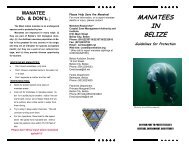The Placencia Lagoon - Coastal Zone Management Authority and ...
The Placencia Lagoon - Coastal Zone Management Authority and ...
The Placencia Lagoon - Coastal Zone Management Authority and ...
Create successful ePaper yourself
Turn your PDF publications into a flip-book with our unique Google optimized e-Paper software.
<strong>The</strong> salinity maps presented in Appendix 2 display shifts in salinity distribution within<br />
the lagoon. This could be attributed to the effects of evaporation, freshwater influx from<br />
the <strong>Placencia</strong> catchments <strong>and</strong> the net water exchange between the entire estuarine system<br />
<strong>and</strong> the sea. <strong>The</strong> fact that the salinity is a conservative parameter allows us to make<br />
certain conclusions about the character of the lagoon. For instance, the monitoring<br />
surveys in the peak of two dry seasons (2001 & 2003) indicate that the upper section of<br />
the lagoon maintains a much lower salinity relative to the mouth of the lagoon. In effect<br />
this is a clear indication that the flushing rate of the upper part of the lagoon during the<br />
dry season is very low <strong>and</strong> is strongly dependent on wind <strong>and</strong> tidal forces. This is one<br />
natural attribute of the lagoon that highlights its vulnerability to the impacts of human<br />
settlement <strong>and</strong> aquaculture developments. Hypothetically, if large volumes of wastewater<br />
or untreated effluents were discharged into the upper section of the <strong>Placencia</strong> <strong>Lagoon</strong>, its<br />
water quality would rapidly decline <strong>and</strong> affect the natural ecological balance.<br />
Another characteristic of the lagoon is that during the dry season there are minimal<br />
differences between surface <strong>and</strong> bottom salinities. Based on this observation, the<br />
<strong>Placencia</strong> <strong>Lagoon</strong> is classified as a moderately stratified estuary.<br />
Dissolved Oxygen concentration is one of the best indicators of an estuary’s health. An<br />
estuary with little or no oxygen cannot support healthy levels of animal or plant life. <strong>The</strong><br />
aerobic bacteriological decomposition of organic matter requires Oxygen. Quite often<br />
this process depletes the water of oxygen <strong>and</strong> makes the environment uninhabitable for<br />
other organisms.<br />
Most animals <strong>and</strong> plants can grow healthy <strong>and</strong> reproduce when DO levels exceed 5 mg/L.<br />
However, when DO levels falls to 3-5 mg/L living organisms may become stressed. <strong>The</strong><br />
results of the surveys indicate that the <strong>Placencia</strong> <strong>Lagoon</strong> is a healthy environment<br />
displaying a wide range of dissolved oxygen concentration (between 5.79 <strong>and</strong> 8.02<br />
mg/L).<br />
Several studies in estuaries have shown that although excess nutrients from human<br />
activities are a major cause of hypoxia <strong>and</strong> anoxia, these conditions may also occur in<br />
estuaries relatively remote from human impact. However, the severity of low DO <strong>and</strong> the<br />
length of time that low oxygen conditions persist are less extreme. This is another good<br />
reason for a proactive approach to manage the impact of anthropogenic activities in the<br />
lagoon catchments. Offsetting the balance of the healthy <strong>Placencia</strong> <strong>Lagoon</strong> towards an<br />
anoxic <strong>and</strong> unproductive environment can be avoided.<br />
During the monitoring surveys the turbidity levels in the lagoon were influenced<br />
primarily by the intensity <strong>and</strong> duration of the wave action. <strong>The</strong> amount of mixing<br />
ultimately controlled the re-suspension of silt <strong>and</strong> organic matter into the water column.<br />
<strong>The</strong> perturbation in the extremely shallow parts of the lagoon was more vigorous as<br />
opposed to deeper parts <strong>and</strong> this was reflected in the heterogeneous turbidity levels.<br />
Generally, the turbidity levels were low as indicated by the averaged values ranging<br />
between 4.32 <strong>and</strong> 10.64 NTU. During the final survey (July, 03), some parts of the<br />
27



